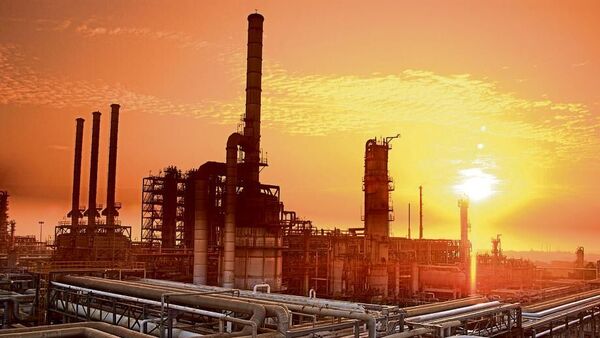
Oil futures steadied on May 16 as support from a higher global demand forecast from the International Energy Agency (IEA) was countered by weaker-than-expected China’s economic data on lower domestic and export growth. The Paris-based agency gathering of the 31 mostly industrialised countries and much of the European Union (EU) raised its forecast for global oil demand this year by 200,000 barrels per day (bpd) to a record 102 million bpd.
Oil futures steadied on May 16 as support from a higher global demand forecast from the International Energy Agency (IEA) was countered by weaker-than-expected China’s economic data on lower domestic and export growth. The Paris-based agency gathering of the 31 mostly industrialised countries and much of the European Union (EU) raised its forecast for global oil demand this year by 200,000 barrels per day (bpd) to a record 102 million bpd.
Brent crude futures eased by 11 cents, or 0.2 per cent, to $75.12 a barrel while US West Texas Intermediate crude was down 12 cents, or 0.2 per cent, at $70.99. Both benchmarks rose more than 1 per cent on May 15, reversing a three-session losing streak. Currently, China’s economic data, India’s windfall tax on petroleum crude, OPEC+ cuts are among the major triggers for oil prices.
Brent crude futures eased by 11 cents, or 0.2 per cent, to $75.12 a barrel while US West Texas Intermediate crude was down 12 cents, or 0.2 per cent, at $70.99. Both benchmarks rose more than 1 per cent on May 15, reversing a three-session losing streak. Currently, China’s economic data, India’s windfall tax on petroleum crude, OPEC+ cuts are among the major triggers for oil prices.
Subscribe to Continue Reading
Key factors affecting oil prices:
China’s April economy loses steam: China’s industrial output grew 5.6 per cent in April from a year earlier, accelerating from the 3.9 per cent pace seen in March, as per data released by the National Bureau of Statistics (NBS). It was below expectations of a 10.9 per cent increase according to a Reuters poll of analysts, although it marked the quickest growth rate since September 2022.
The April industrial output and retail sales growth came in much below forecasts, suggesting the economy lost momentum at the beginning of the second quarter. Retail sales – an indicator of consumption, jumped 18.4 per cent, up sharply from a 10.6 per cent increase in March for their fastest increase since March 2021, however analysts had expected 21 per cent growth.
China’s recovery after the lifting of COVID-19 curbs had surpassed expectations, with demand reaching a record 16 million bpd in March, according to the IEA. Tuesday’s data also showed a further decline in property investment, which adds to concerns about the outlook for the world’s second-biggest economy as both its domestic and export engines of growth were sluggish.
India cuts windfall tax on crude to zero: The government has cut the windfall tax on petroleum crude to nil per tonne from ₹4,100 effective from May 16, according to a government notification. The government left the windfall tax on petrol, diesel and aviation turbine fuel at zero. The government revises tax rates fortnightly based on oil price fluctuations.
On May 1, the government cut the windfall tax on petroleum crude to 4,100 rupees ($50.14) per tonne from 6,400 rupees per tonne. The levy on crude was hiked to 6,400 rupees per tonne on April 19. Last year, India imposed the windfall tax on crude oil producers and extended the levy on exports of gasoline, diesel and aviation fuel after private refiners wanted to make gains from robust refining margins in overseas markets, instead of selling at home.
India to challenge EU carbon tax at WTO: The government plans to file a complaint to the World Trade Organisation over the European Union’s proposal to impose 20 per cent to 35 per cent tariffs on imports of high-carbon goods like steel, iron ore and cement from India, according to news agency Reuters.
This is part of India’s strategy to combat the EU’s Carbon Border Adjustment Mechanism (CBAM) designed to push local industries to invest in new technologies to bring down carbon emissions, while also raising the issue in bilateral talks.
Last month, the EU approved the world’s first plan to impose a levy on high-carbon goods imports from 2026, targeting imports of steel, cement, aluminium, fertilisers, electricity, and hydrogen, aiming to become a net zero emitter of greenhouse gases by 2050, ahead of India’s target of 2070.
OPEC+ output to decide price swing: Global crude supplies could tighten in the second half as the Organization of the Petroleum Exporting Countries (OPEC) and allies including Russia, together known as OPEC+, implement additional output cuts in its next meeting on June 4 or anytime throughout the year.
Dutch ING said in a recent oil market update that while oil prices remain depressed for now, things could very well change in the second part of the year, with a deficit looming on the horizon. The basis for this forecast is a combination of lower OPEC+ output, higher demand outside the OECD, and a smaller-than-expected growth in US output, according to ING.
Citi’s commodities head Ed Morse recently told CNBC that oil prices may have bottomed out, and we’re entering peak demand season in the much more populated northern hemisphere.
However, China’s economic data on Tuesday also highlighted that 18.9 per cent rise in the country’s oil refinery throughput in April from a year earlier to the second-highest on record helped to keep a floor under crude prices.
“The risks remain tilted to the downside amid a sluggish recovery in China, uncertainty around the US economy and banking system and the impact of much higher interest rates on demand,” OANDA analyst Craig Erlam told Reuters.






